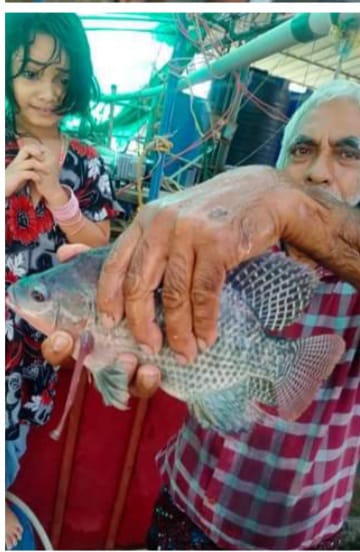When Sageer Upahara’s pandal work was hit during the pandemic, like many others, he sought help from social media to hunt for a new job. “I was browsing for work from home options when I came across the concept of fish farming on terraces,” the 37-year-old native of Thrissur, Kerala tells The Better India.
He began breeding fish on a trial basis. “I was a little worried because I had no experience in breeding fish. YouTube videos helped me understand the process in detail,” he says.
First, Sageer did research on how to construct a fish tank on his terrace. He made it using frames, cement and a tarpaulin. Then, he contacted a fish nursery in Thrissur and bought 1,000 fingerlings of tilapia fish. The pandal worker also brought a motor to purify the water in the pond, aerators, nets, and fish feed, which cost him about Rs 37,000. This money came from his savings as a pandal worker.

Around 20 fish died, unable to adjust to their new surroundings, but the remaining grew well in the 10,000-litre tank. They were fed growel fish feed twice a day. “Maintaining a feeding routine helps the fish lead a stable life. My children feed the fish in my absence, or my wife or parents do it,” he says.
Along with breeding tilapia, Sageer also grows vegetables using aquaponics. Nutrients from the fish waste pose as food for the produce. “I have been cultivating spinach, tomato, and lady’s finger using this method. This technique helps in good growth of the plants, and also helps purify the water,” he says.
After about six months, in December 2020, he harvested around 200 kilos of fish. Each fish weighed around 500 grams. Some premature fish were retained in the tank to be harvested for the next season.
A host of health benefits

“Tilapia fish can be eaten, and has mild and white fillets that are appropriate for making at home as well as by restaurants,” he says. Sageer’s tilapias were mainly sold to villagers in his area, at Rs 230 per kilo, earning around Rs 46,000. The villagers, who were mostly unfamiliar with fish farming at home, were more than interested to buy from him.
While conducting his research on the fish, Sageer realised how many health benefits they carry. Tilapias have omega-3 fatty acids which have been linked to lower risk of heart attacks and strokes. The fish is also good for the brain and offers protection against degenerative mental conditions such as dementia. It is also good for bone health and is a good source of potassium and selenium.
Sageer now breeds pangasius fish as well. He has constructed a new tank of the ground floor, after having run out of space on the terrace. The 16,000-litre tank houses around 400 fingerlings of pangasius. “I bought them from the same nursery at Rs 8 each. Pangasius is similar to tilapia in the sense that it can be harvested within six months. I’ll do that in April this year,” he says.
Pangasius also has numerous health benefits — it is rich in protein, has zero sodium, and is low in saturated fat and cholesterol.
Pandal work has since resumed after the lockdown ended, but Sageer says he is planning to expand his fish farm and breed more varieties in the coming years.
(Edited by Divya Sethu)
No comments:
Post a Comment